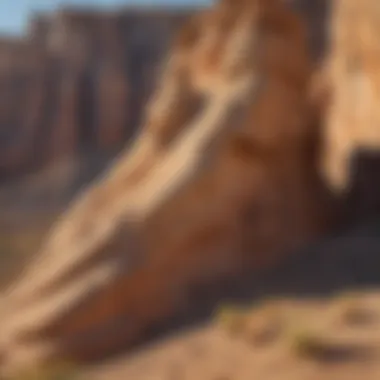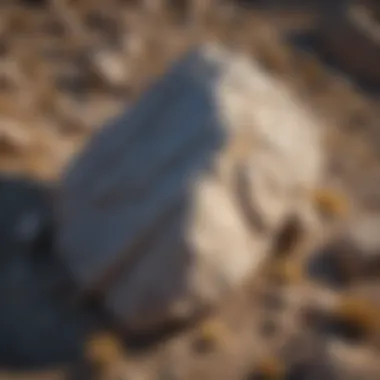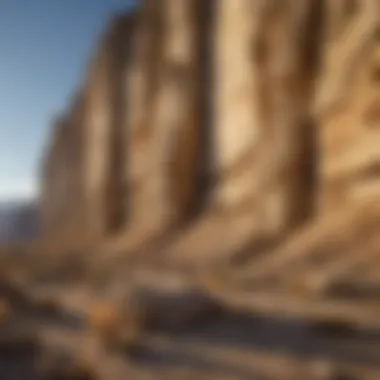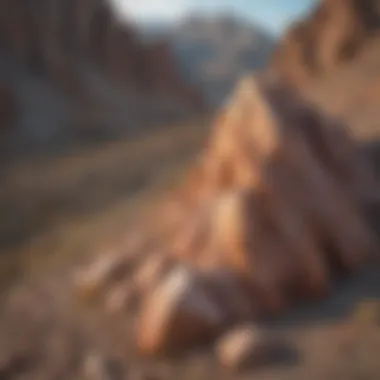Discovering the Diverse Array of Nevada's Unique Rocks


Rock and Fossil Identification
Nevada's vast landscape is a treasure trove of rocks waiting to be explored. From sedimentary layers to intricate metamorphic formations, the diversity of rocks found in Nevada is a geological enthusiast's dream. When identifying rocks in this region, it is crucial to understand the various types and their key characteristics. Sedimentary rocks, formed by the deposition of sediments over time, can be recognized by their layered structure and often contain fossils embedded within them. In contrast, metamorphic rocks, altered by heat and pressure, exhibit distinct bands and foliated textures.
To aid in rock and fossil identification, collectors should familiarize themselves with the tools of the trade. Magnifying lenses can help examine finer details, while hardness picks assist in determining the rock's mineral content. Additionally, geologists use streak plates to determine a rock's color when powdered, aiding in classification.
Collecting Tips and Techniques
Embarking on a rock-collecting expedition in Nevada requires careful planning and adherence to best practices. Identifying prime collecting sites is paramount, as certain areas may yield a higher concentration of rare specimens. Local geological maps and online resources can guide collectors to areas rich in diverse rock formations.
When collecting rocks, it is essential to practice responsible excavation techniques. Tools like rock hammers and chisels can aid in safely extracting specimens without causing damage to surrounding geological features. Moreover, maintaining respect for the environment by filling any excavated holes and avoiding protected areas is crucial to preserving Nevada's geological heritage.
Preservation and Display
Once collected, rocks and fossils must be preserved to maintain their integrity and prevent deterioration. Techniques such as sealing rocks with a clear sealant can protect them from exposure to air and moisture, preventing oxidation and discoloration. Storing specimens in a controlled environment away from direct sunlight and extreme temperatures ensures their longevity.
Displaying rocks and fossils can be both a scientific endeavor and an artistic expression. Creative enthusiasts often arrange specimens in shadow boxes or display cases, highlighting the unique features of each rock. Utilizing labels and informative plaques can enhance the educational value of the display, providing insights into the geological significance of each specimen.
Geological Insights
Delving deeper into Nevada's geological formations unveils a rich tapestry of historical significance and notable discoveries. The intricate layers of sedimentary rocks reveal the region's prehistoric past, offering insights into ancient environments and past life forms. Metamorphic formations, shaped by tectonic forces over millennia, showcase the dynamic geological processes that have shaped Nevada's landscape.
Throughout history, significant discoveries in the field of geology have been made in Nevada. Fossil finds have provided valuable information about past ecosystems and species that once roamed the region. Understanding the geological context of these discoveries requires meticulous research and analysis, shedding light on the Earth's ever-evolving geological narrative.
Introduction
Welcome to the insightful journey that unravels the diverse realm of rocks nestled within the geological tapestry of Nevada. Rock formations stand as silent witnesses to the ever-changing landscapes, narrating tales of time immemorial. In this article, we traverse through the nooks and crannies of Nevada, exploring the rich assortment of rocks that punctuate its terrain. Delving beyond the surface, we uncover the hidden treasures of sedimentary, metamorphic, and igneous rocks that shape Nevada's unique geological identity.


As we embark on this expedition, the significance of understanding the various types of rocks in Nevada becomes paramount. Rocks are not just inert objects but poignant storytellers that carry the geological history of a region. By deciphering the composition and formation processes of these rocks, we gain invaluable insights into the earth's intricate mechanisms and the forces that have sculpted Nevada's terrain over millennia. This exploration is not merely a scientific endeavor; it is a testament to Nature's artistry and the interconnectedness of geology with our existence.
Overview of Nevada's Geology
Nevada's geology is a window into the Earth's ancient past, holding secrets of its formation and evolution over millions of years. The diverse landscape of Nevada is a result of intricate geological processes that have shaped its rocks into a myriad of forms and compositions. Understanding the geological composition of Nevada is crucial for unraveling the state's geological history and the forces that have acted upon it.
Geological Composition
The geological composition of Nevada is a fascinating tapestry of various rock types that provide clues to its formation. Sedimentary rocks like limestone, sandstone, and shale dominate certain regions, showcasing the deposition of materials over time. Metamorphic rocks such as marble, slate, and quartzite reveal the transformative effects of heat and pressure deep within the Earth. Igneous rocks like granite, rhyolite, and basalt display solidification from molten magma, representing volcanic activity. Each rock type in Nevada contributes to the state's complex geology and offers insights into different geological processes that have shaped the landscape.
Tectonic Activity
Nevada's tectonic activity has played a pivotal role in shaping its geology. The region sits at the boundary of several tectonic plates, leading to significant geological events such as mountain-building and faulting. The movement of these plates has created diverse landscapes in Nevada, with mountains, valleys, and basins dotting the terrain. Tectonic forces continue to influence the state's geology, causing earthquakes and volcanic activity that contribute to the dynamic nature of Nevada's rocks.
Formation Processes
The formation processes of rocks in Nevada are a testament to the Earth's constant changes. From the sedimentation of ancient seas that created limestone to the metamorphism of sedimentary rocks under intense heat and pressure, each rock type tells a story of its origins. Igneous rocks, formed from volcanic eruptions and magma intrusions, highlight the violent forces that have shaped Nevada's geology. Understanding these formation processes is key to deciphering the geological history of Nevada and appreciating the intricate processes that have sculpted its rocks into unique formations.
Types of Rocks in Nevada
Nevada's geological landscape is a treasure trove of diverse rock formations, each holding its own significance and unique characteristics. Understanding the different types of rocks in Nevada is crucial for rock and fossil enthusiasts to truly appreciate the geological wonders that the region offers. From sedimentary, metamorphic, to igneous rocks, Nevada showcases a wide range of rock formations that tell a fascinating story of the Earth's history and formation.
Sedimentary Rocks
Limestone
Limestone, a prevalent sedimentary rock in Nevada, plays a crucial role in the state's geology. Its composition primarily consists of calcium carbonate derived from marine organisms' skeletal fragments. Limestone's key characteristic lies in its ability to withstand weathering and erosion, making it a popular choice for building materials and decorative purposes. The unique feature of limestone is its rich fossil content, preserving ancient marine life forms within its layers. While limestone offers durability and aesthetic appeal, its drawback lies in its susceptibility to acidic environments, leading to erosion over time.


Sandstone
Sandstone, another prominent sedimentary rock found in Nevada, is known for its textured surface and varied color palettes due to mineral impurities. Its contribution to Nevada's geology is significant, as sandstone deposition indicates past desert environments or ancient riverbeds. The key characteristic of sandstone is its porosity, allowing water to seep through its layers, making it valuable for groundwater storage. Sandstone's unique feature lies in its role as an aquifer, providing essential water sources in arid regions. While sandstone presents excellent hydraulic conductivity, its disadvantages include susceptibility to weathering and brittle behavior.
Shale
Shale, a common sedimentary rock in Nevada, is essential for understanding the state's geological history. It is characterized by its fine-grained texture, formed from compressed mud and clay particles. Shale contributes significantly to the overall topic by serving as a seal for oil and gas deposits, influencing resource exploration. The key characteristic of shale is its fissility, making it easily split into thin layers. Plus, shale's unique feature lies in its high organic content, which can contribute to hydrocarbon reserves. While shale offers valuable insights into past environments and resource potential, its disadvantages include low permeability, limiting fluid movement in subsurface formations.
Metamorphic Rocks
Marble
Marble, a metamorphic rock in Nevada, boasts distinctive qualities that add to the state's rock diversity. Formed from limestone subjected to high pressure and temperatures, marble is renowned for its elegance and versatility in construction and artistic applications. The key characteristic of marble is its unique veining patterns, enhancing its aesthetic appeal. Marble's advantages include durability, heat resistance, and the ability to be polished to a high sheen. However, marble's disadvantages include susceptibility to acid etching and scratching, requiring care in maintenance.
Slate
Slate, another metamorphic rock abundant in Nevada, plays a vital role in both geology and industry. Derived from shale subjected to metamorphism, slate is prized for its durability and weather-resistant properties. The key characteristic of slate is its fine-grained texture, allowing it to be split into thin, flat sheets known as 'slates.' Slate's unique feature lies in its diverse color range and use in roofing, flooring, and cladding applications. While slate offers longevity and low water absorption rates, its disadvantages include brittleness and potential delamination over time.
Quartzite
Quartzite, a metamorphic rock that originated as sandstone, contributes significantly to Nevada's diverse rock formations. Through intense heat and pressure, sandstone transforms into quartzite, resulting in a hard, durable rock with sparkling quartz crystals interwoven in its structure. The key characteristic of quartzite is its resistance to heat and natural variations in color. Quartzite's unique feature lies in its non-foliated texture, making it ideal for countertops, flooring, and wall construction. While quartzite offers strength and beauty, its disadvantages include being prone to etching from acidic substances and requiring periodic sealing for maintenance.
Igneous Rocks
Granite
Granite, an igneous rock prevalent in Nevada, is a testament to the state's volcanic history. Formed from the slow crystallization of magma deep beneath the Earth's surface, granite is known for its durability and striking appearance. The key characteristic of granite is its interlocking mineral grains, creating a speckled or swirled patterning. Granite's unique feature lies in its resistance to heat, scratches, and stains, making it a popular choice for countertops and monuments. While granite offers longevity and aesthetic appeal, its disadvantages include the need for periodic sealing to maintain its luster.


Rhyolite
Rhyolite, an igneous rock found in Nevada, offers insights into the region's volcanic eruptions and magma compositions. Characterized by its high silica content, rhyolite ranges in color from light gray to pink, showcasing its volcanic origins. The key characteristic of rhyolite is its fine-grained texture, resulting from rapid cooling above ground. Rhyolite's unique feature lies in its historical significance as evidence of past volcanic activities. While rhyolite presents an attractive appearance and potential use in construction, its disadvantages include brittleness and limited resistance to abrasion.
Basalt
Basalt, a common igneous rock across Nevada, reflects the state's volcanic past and basaltic lava flows. Formed from rapid cooling of lava, basalt is known for its dark color and fine-grained texture. The key characteristic of basalt is its high iron and magnesium content, giving it a dense and durable nature. Basalt's unique feature lies in its use as construction material, particularly in road pavements and building foundations. While basalt offers strength and resistance to weathering, its disadvantages include limited availability in specific regions and challenges in shaping due to its hardness.
Unique Formations
Geodes
Geodes, unique formations in Nevada, offer a glimpse into the captivating world of crystal-filled cavities within rocks. These spherical structures often contain beautiful crystals like quartz, calcite, and amethyst. The key characteristic of geodes is their hollow interiors lined with stunning crystalline deposits. Geodes' unique feature lies in the variety of crystals they house, making them coveted collector's items and decorative pieces. While geodes provide insight into mineral formation processes and geological history, their disadvantages include fragility and brittleness, requiring careful handling.
Petrified Wood
Petrified wood, a fascinating relic in Nevada, preserves ancient wood transformed into stone through the process of fossilization. This unique formation occurs when organic material undergoes mineral replacement, turning into stone over millions of years. The key characteristic of petrified wood is its detailed preservation of tree rings and organic structures, offering clues to past environments. Petrified wood's unique feature lies in its display of varied colors and textures, resembling the original wood's appearance. While petrified wood serves as a valuable tool for understanding ancient landscapes and climate changes, its disadvantages include susceptibility to fracturing and fading if exposed to sunlight.
Obsidian Flow
Obsidian flows, remarkable geological features in Nevada, highlight the region's volcanic past and rapid lava cooling processes. Lustrous and black, obsidian forms from the rapid solidification of lava flow, lacking crystalline structure. The key characteristic of obsidian flow is its sharp edges and glassy texture, making it ideal for tool-making by prehistoric civilizations. Obsidian's unique feature lies in its use as protective tools, weapons, and decorative objects due to its sharpness and reflective qualities. While obsidian flows offer insights into ancient technology and trade networks, their disadvantages include brittleness and limited availability for large-scale use.
Significance of Rock Diversity in Nevada
The Significance of Rock Diversity in Nevada is a crucial aspect of geological exploration. Nevada's diverse range of rocks, including sedimentary, metamorphic, and igneous formations, offers a unique opportunity to study Earth's history and evolution. These rocks serve as a timeline of geological processes over millions of years, providing insights into past environments and tectonic activities. Understanding the rock diversity in Nevada not only aids in scientific research but also contributes to fields such as environmental conservation, geology, and mineral exploration.
One key element of the Significance of Rock Diversity in Nevada is the preservation of fossils within sedimentary rocks. These fossils offer a glimpse into ancient flora and fauna, allowing researchers to reconstruct past ecosystems and understand evolutionary patterns. In addition, metamorphic rocks in Nevada provide evidence of intense heat and pressure deep within the Earth, shedding light on the geologic events that shaped the region. By studying the diverse rocks of Nevada, scientists can unravel the intricate geologic history of the area and draw connections to global processes.
Furthermore, the Significance of Rock Diversity in Nevada extends to economic benefits such as mineral resources. Igneous rocks like granite and basalt host valuable minerals that are essential for construction, manufacturing, and technological advancements. The presence of unique formations like geodes and obsidian flows not only attracts rock and fossil collectors but also contributes to tourism and local economies. Rock diversity in Nevada plays a vital role in showcasing the natural beauty and geological significance of the region, making it a hotspot for geological enthusiasts and researchers alike.
Conclusion
Nevada's diverse collection of rocks stands as a testament to the intricate geological processes that have shaped the region over millions of years. As we conclude our exploration of the various types of rocks in Nevada, it becomes evident that each rock type encapsulates a unique geological history and pivotal information about the earth's ancient past. Understanding the significance of rock diversity in Nevada is not merely a matter of academic interest but serves as a window into the unparalleled beauty and complexity of nature's creations. By delving into the different rock formations in the region, we gain profound insights into the forces of nature that have sculpted Nevada's landscapes and enriched its geological heritage. The diverse range of rocks, from sedimentary layers to metamorphic transformations and igneous creations, paints a vivid picture of the geological evolution that has unfolded in Nevada. Exploring these rocks provides a deep connection to the earth's history and offers a profound appreciation for the wonders of nature. Moreover, the rocks in Nevada not only offer visual splendor but also harbor invaluable scientific information that aids in deciphering the earth's geological mysteries. By recognizing the importance of rock diversity, we come to grasp the intricate interplay between geological forces and environmental conditions that have led to the formation of Nevada's distinct rock types. Therefore, embracing the rock diversity in Nevada unveils a treasure trove of knowledge, beauty, and scientific significance that enriches our understanding of the planet we call home.







